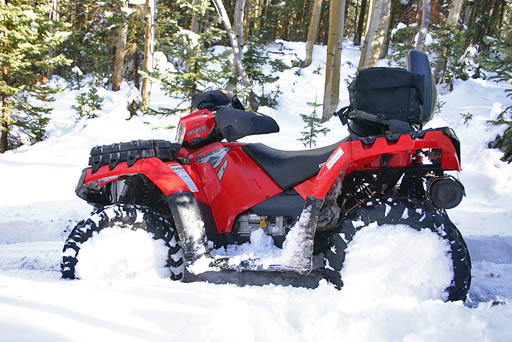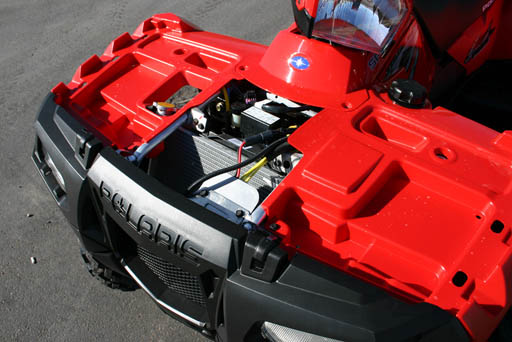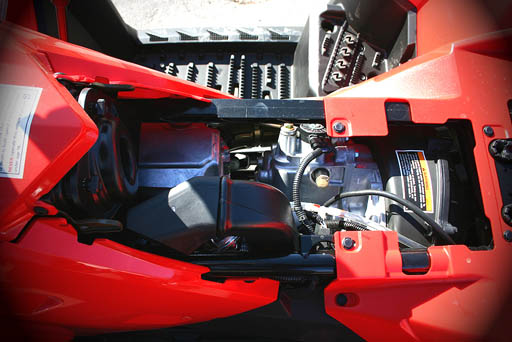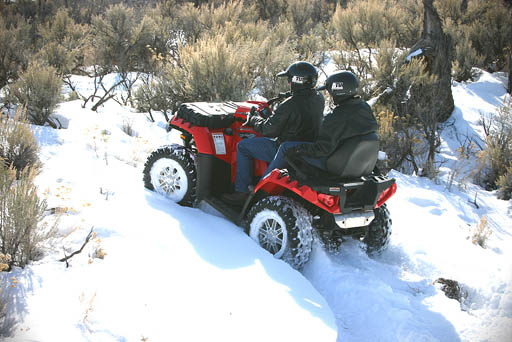

The world has gone mad! Even the constants in our industry can no longer be taken for granted. Polaris ATVs have real, honest-to-goodness a-arm front suspensions and round tubing frames! It’s true! What’s next, twin brake controls? A drive system that allows 4wd in reverse and engine braking to all four wheels?
Polaris introduced a host of new changes including front a-arms, round tubular frames, longitudinal engine and transmission placement as well as a bunch of other evolutionary changes to their new Sportsman XP line in 2009. Now, for 2010 they have expanded that same line of development to the 2-seat Touring models.
As you can imagine, it’s not hard to spot the differences in the XP models. First of all – they’re great-looking – especially how the new racks wrap around into the fenders. But of course, the biggest news is that the front suspension now has dual a-arms that provide a full 9 inches of more precise wheel travel. The best part of this change from struts to a-arms is that a-arms give the XP a much better controlled wheel travel with less camber gain as it moves up through its travel. In addition, the front arms have also been designed with less offset to the steering geometry. The center of the wheel and tire is located at the center of the steering knuckle to provide less kickback through the handlebars when hitting uneven terrain or rocks and stumps with the tire. Also new are the 14 inch wheels and tires. And while they may not improve handling or steering, they certainly do look good!
On the rear, the a-arms have been modified with what is referred to as ‘roll.’ Roll refers to the arm’s mounting points, now angled a bit so that the rear tires move slightly rearward as they move upward, thus making the upward travel of the wheel and tire a less abrupt movement when hitting obstacles. The rear suspension has 10 ¼ inches of very useful travel. And there are now preload adjustable shocks on all corners of the XP. So, unlike past Sportmans, where you only had preload adjustability on the rear, the XP Touring’s front shocks can now be stiffened for hauling bigger loads or even when attaching a snowplow in the winter months. The change to a-arms also opens the door for the ability to install better aftermarket shocks on the XP for even better ride and handling!
Another big change that you don’t readily see but that makes a really big difference in the feel and handling of the XP is the new engine. The engine now sits longitudinally in the frame making it a much narrower package. But there are other changes as well. The SOHC, 550 cc single cylinder engine is fuel injected for easy starting and smooth running at any elevation or weather condition. Rated at 42 horsepower, the new engine is powerful enough to carry two people and all their gear up almost any mountain trail.
Because the engine now sits 90-degrees from what it was in the past, means that the CVT transmission on the XP sits behind the engine rather than alongside it. That new arrangement makes the XP a whopping 8 inches narrower than the old, standard Sportsman.
Climbing on the XP, you’ll quickly notice just how narrow it is, now feeling more like a regular ATV (dare I even say sport quad?) as you can sit on the XP without the bowlegged feeling of a skinny cowboy riding a fat horse. That loss of 8 inches of girth makes it much easier for the rider to move around in the saddle and shift their weight around for better control. But Polaris lovers rest easy as, although the seat is very narrow at the front, it fills out toward the back still having plenty of that good old Sportsman cush for those long rides in the saddle. Other than making the machine narrower, the longitudinal placement of the engine and transmission also has the advantage of being more efficient as the crankshaft now turns in the same plane as the driveshafts.
Both the engine and transmission are rubber mounted in the frame for less vibration and noise transfer up through the frame to the rider. And that brings us to the frame – also completely new and a total departure from Sportsmans of the past. Where the old frames looked more like they belonged on a tractor, being a combination of square tubing and stamped steel pieces, the new frame is a double-cradle of round tubing just like’s found on (here we go again!) sport quads. Not only is a round tubing frame stronger and lighter, but better looking as well!
Maintenance is easy with the battery located directly under the pop-off seat with the terminals within easy reach for checking, charging or just attaching a float-charger. With the seat removed you find the air filter located under a cover where the fuel tank used to be. The 4 ½ gallon fuel tank has been moved lower and in front of the engine’s cylinder. All these changes help to centralize and lower the main weight of the Sportsman, again all in an effort to make it handle better and be more responsive and more nimble to maneuver in the more difficult and rough terrain.
The gauges too have been revised, now being a completely digital unit that includes a speedometer, odometer, tachometer, two trip odometers, hour meter, clock, gear indicator, fuel gauge, and warning lights for temperature and battery condition.
Also new this year is the availability of Electric Power Steering (EPS) as an option. While the value of power steering can certainly be argued on most ATVs, the addition of EPS on a two-seat ATV is an unequivocal asset! The value of the EPS system on the Touring can easily be found at the end of an all-day ride. Coming down a long, steep and rocky trail with all the weight of the big ATV and the additional weight of a passenger all moved forward to the front wheels can really take its toll on tired arms. The power steering makes it all a breeze with the stabilizing effect definitely keeping the rocks and ruts from ripping the handlebars from your hands. Although the unit provides less feel than we prefer, that may change with the addition of better, more aggressive tires.
And that brings up our first problem with the Touring. With all the changes Polaris made to the new XP, we sure wish they would have continued their practice of putting top level tires on this machine. The standard bias-ply Maxxis tires that come on the Touring are okay, but the XP would certainly benefit from the addition of a tire like the PXT radial!
Big deal, so the tires could be better. The big question is whether or not it’s better out on the trails than the old style Sportsman? If you are seriously wondering that I’ll try not to laugh and say, “Are you kidding me?” Like the older Sportsman, it’s still incredibly comfortable and easy to ride out on the more open trails, but now, thanks to all the changes, it’s more nimble and easier to ride when the going gets rough and tough. Remember though, at a bit over 770 pounds, it’s still a very heavy machine to muscle around on the tighter trails and in those off-camber situations.
Although the CVT transmission works incredibly once you’re moving, getting it moving from a standstill continues to require far too many revs. We much prefer a transmission to hook up quickly, right off of idle. And finally there’s a Polaris 4wd system that works in reverse without having to push a button! Now if they could just make the engine braking go to all 4 wheels! That continues to be every test rider’s biggest complaint about Polaris’s of all sorts. At least the ADC (Automatic Decent Control) allows the engine braking to go to all 4wd wheels when it’s engaged. Unfortunately the ADC only works when you are going less than 15mph and have no throttle applied. This all could be solved if Polaris would just make the switch to a conventional 4-wheel drive system. At the least I imagine they’ll soon have ADC work all the time, and at any speed. For now, the longer wheelbase of the Touring helps keep the ATV more inline on those steep declines.
We really like the longer wheelbase on the Touring. Not only does it make the machine a much more stable platform when there’re two people onboard, but even ridden solo it has a more planted feel. The only downside we found to the added 4 inches of wheelbase is the increase in territory that’s required to turn the Touring around, which is seldom as big of a problem as we thought it might be thanks to the very sharp turning ability found on the XP.
Polaris Sportsman owners are a loyal bunch. They like the Sportsman because it is a comfortable and capable ATV, and the XP takes those very assets and builds on them. So, if you’re a Polaris Sportsman fan you’ll most likely find the new XP to be the best Sportsman you’ve ever ridden. And if you’ve never been a Polaris fan, then you’ll be amazed by a ride on the new XP Touring. While it still has a few of Polaris’ peculiar features, they have become less overwhelming.



